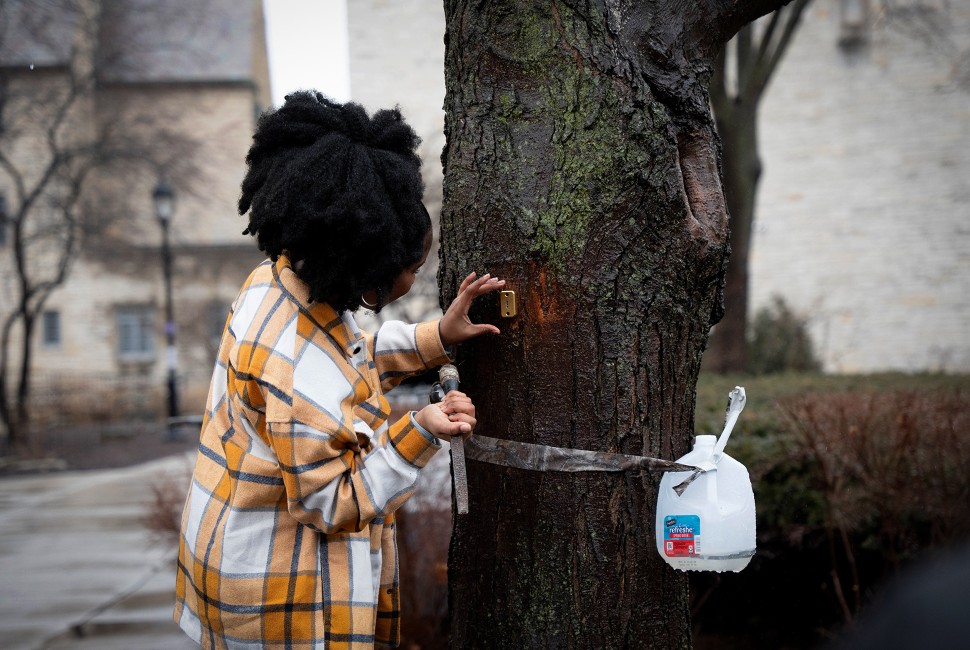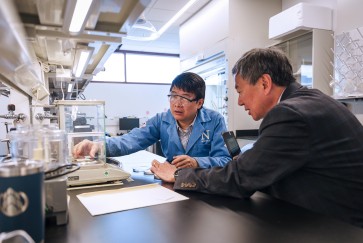Climate change could have an impact on an important part of the day — breakfast.
As a result of fewer trees, reduced tree health and growth, shortened tapping seasons and decreased sap quantity and quality, maple syrup production in the U.S. could slow down, according to the United States Geological Survey, which started a specific network dedicated to the study of maple tree health.
Over a much smaller territory, some professors at Northwestern University are looking to create a clearer picture of what happens when you combine climate change with urban environments. Eli Suzukovich III, an assistant professor of instruction in the Environmental Policy and Culture program within the Weinberg College of Arts and Sciences, and a faculty affiliate of the Center for Native American and Indigenous Research (CNAIR), is in his seventh year teaching a class that aims to do just that.
“Maple Syrup and Climate Change,” offered in the winter quarter of each year through Weinberg and CNAIR, gives students an opportunity to learn not only about the syrup industry and its impact on Native American and non-Native communities, but also to manually tap and monitor maple trees throughout tapping season at pre-determined sites across campus. In addition to recording sap flow, the teams record air and ground temperatures around the trees and look at soil composition via mass spectrometer analysis, which chemist Shelby Hatch helps with.
“Data collection is a slow process,” Suzukovich said.
The class is demanding: Students spend every Friday afternoon, rain, snow or sunshine, manually measuring sap from selected trees and eventually lugging sap in a gallon jug to their dorms in hopes they’ve produced enough to boil down into syrup.
Kadin Mills, a senior in journalism and Native American and Indigenous Studies and a first-generation descendent of the Keweenaw Bay Indian Community from rural Michigan, said he likes the physical element of the course because of how it connects him to the land.
“It’s a really interesting way to connect with the Midwest,” Mills said. “It’s awesome to participate in something cultural and have this finished product of maple syrup at the end. This is my last class of the week and it’s a great opportunity to decompress and spend a few hours outside.”
Now, thanks to a collaboration with two Northwestern engineers and the University of Illinois-Chicago (UIC), Suzukovich and the students are tapping new technology to collect real-time measurements of sap as it moves up and down trees. The net sap flow up a tree provides information about how much water is taken up from the soil, which provides an estimate of the benefits of trees for decreasing flooding from stormwater.
The data will serve several groups even outside the Maple Syrup and Climate Change class, including a massive federal project called Community Research on Climate and Urban Science, or CROCUS.
CROCUS is a $25 million Urban Integrated Field Laboratory research grant funded by the Department of Energy’s Office of Science, Biological and Environmental Research program shared between Argonne National Laboratory, community groups, Northwestern and other area colleges and universities that aims to improve understanding of urban climate change and its impacts in Chicago to form potential solutions to reduce climate vulnerabilities.
For their part, the Northwestern students and their UIC collaborators tapped one group of trees with a digital monitoring system that they will use as a basis of comparison to their manual measurements.
The digital sap monitors assess the rate at which water moves up and down the tree with three tiny probes inserted into holes drilled a couple inches into the bark. One probe is heated at a constant rate while the probes above and below it measure temperature. If the lower probe is cooler, sap is flowing up the tree, and vice versa.
CROCUS aims to build 21 observing stations throughout the Chicago area, with Northwestern serving as its most recent site. Because of its location in Evanston, Northwestern and the North Shore could be important sites for understanding the impact of green spaces and lake breeze on climate change. In addition to high-tech sap monitoring, Northwestern is now home to a device that sits on top of Scott Hall.
Utilities support for CROCUS climate instrumentation on the roof was provided by the Paula M. Trienens Institute for Sustainability and Energy.
The rooftop monitor takes accurate measurements of the air quality, temperature, precipitation and current weather conditions and sends real-time data to a dashboard community members can access.
Aaron Packman, a professor of civil and environmental engineering and director of the Northwestern Center for Water Research, and William M. Miller, a professor emeritus of chemical and biological engineering and the founding director of (and now advisor to) the Center for Engineering Sustainability and Research, lead Northwestern’s charge in the five-year collaboration.
Miller said the major goal of CROCUS is to develop climate models that are able to accurately predict differences in temperature and flooding at a neighborhood, or even block-by-block scale, and to use the models to predict the impacts of interventions such as adding more trees or installing a green roof in neighborhoods that experience higher temperatures or greater flooding.
“Most people are aware that urban areas are warmer than surrounding rural areas, which has been termed the ‘urban heat island effect,’” Miller said. “However, different neighborhoods vary greatly in temperature and stormwater-related flooding, due in large part to differences in the amount and types of trees, parks and other green spaces.
“Areas with little green space and very few trees may be more than 10°F warmer than areas in the same city with extensive green space and tree canopy. To validate models, it is necessary to collect atmospheric, weather, hydrological and biogeochemical data – like sap flow in trees – across the Chicago region.”


